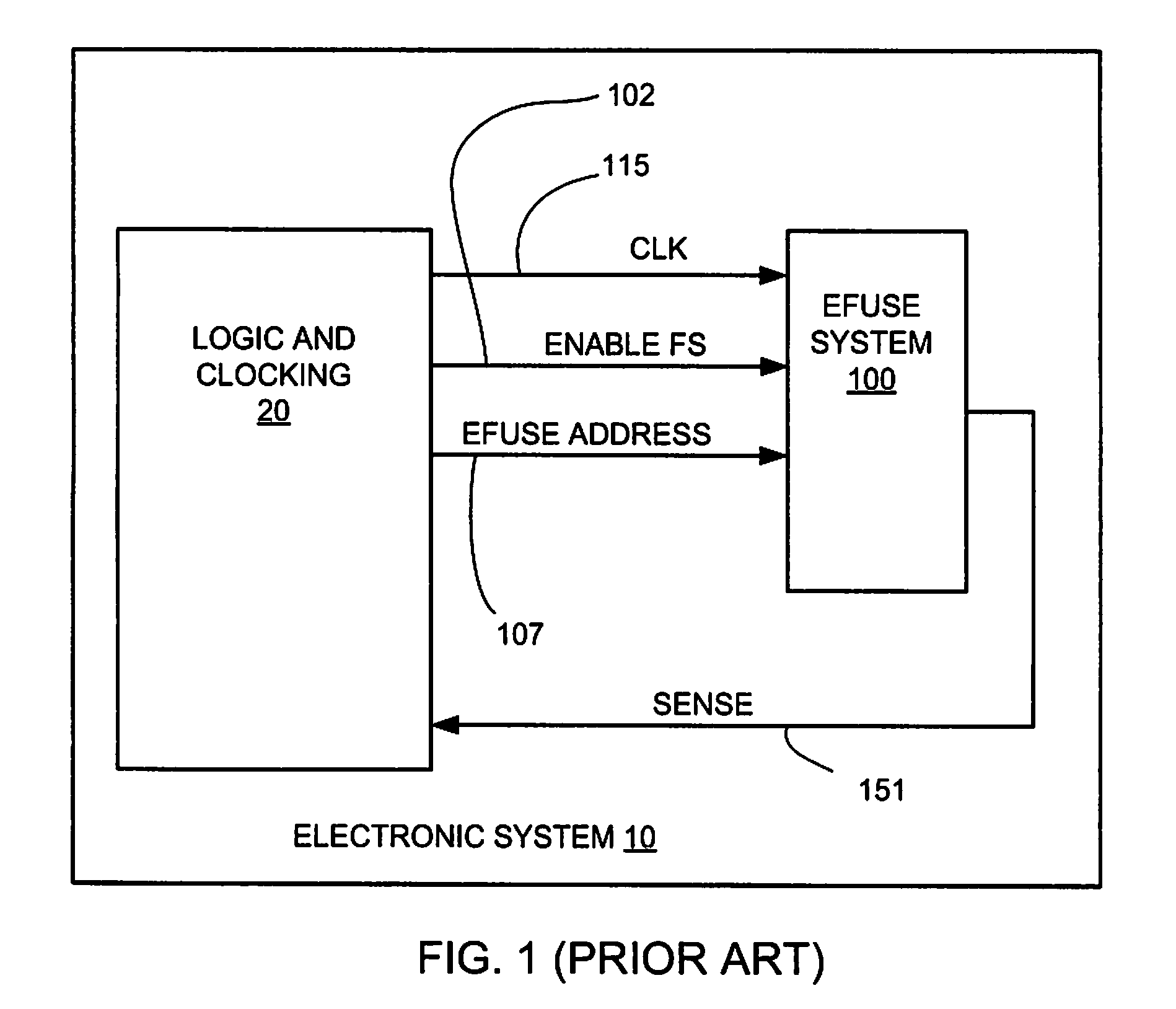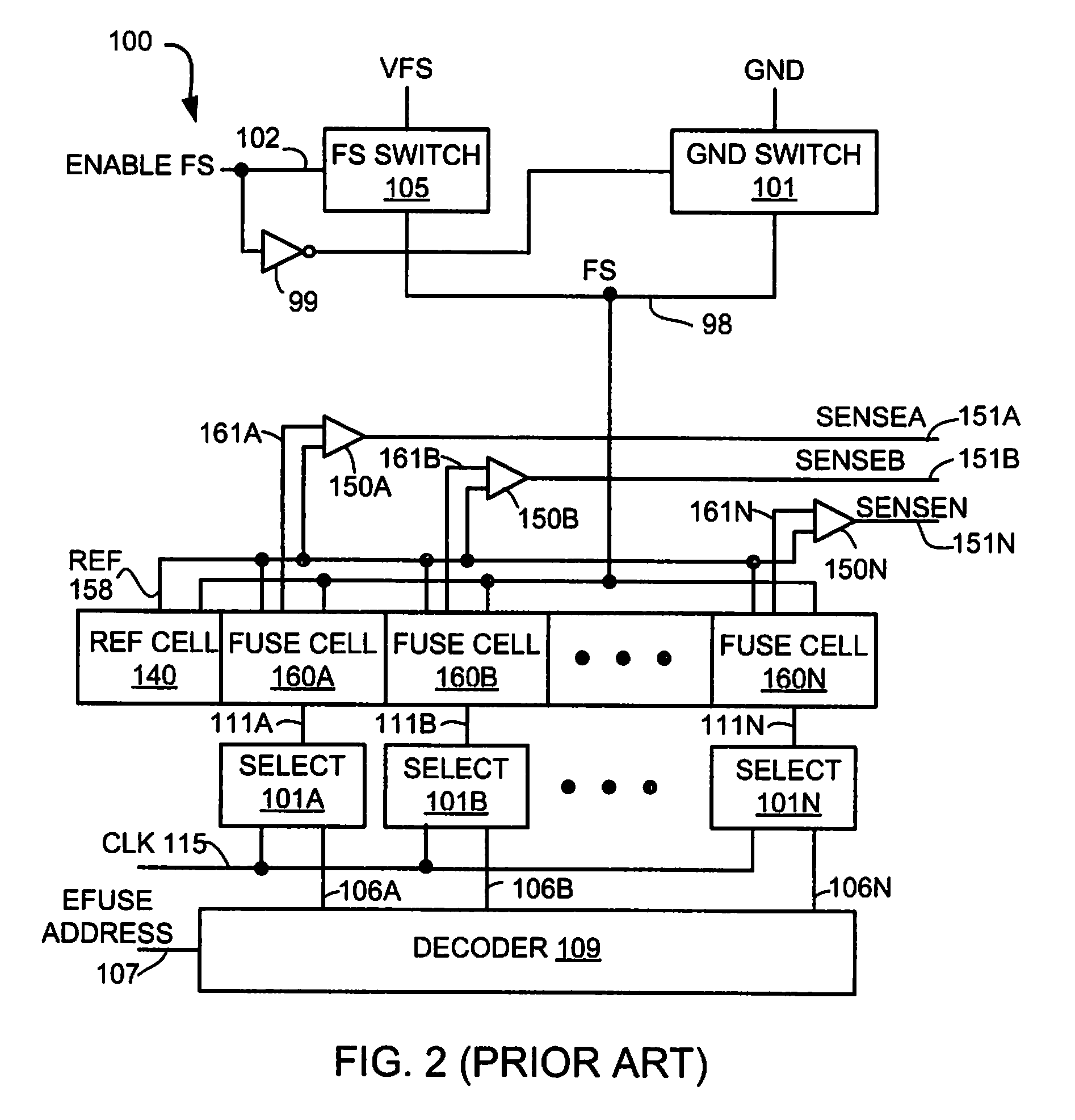Method and Apparatus to Monitor Circuit Variation Effects on Electrically Programmable Fuses
a technology of circuit variation and fuses, applied in the field of one-time programmable memory monitor banks, can solve the problems of increasing the difficulty of sense that an efuse has been successfully blown, chip manufacturing imperfectly, and unusable portions of the chip, and achieve the effect of easy blowing and difficult blowing
- Summary
- Abstract
- Description
- Claims
- Application Information
AI Technical Summary
Benefits of technology
Problems solved by technology
Method used
Image
Examples
embodiment 200
[0050]Referring now to FIG. 3, an eFuse circuit 200 is described. eFuse circuit 200 consists of sense circuitry 201, blow circuitry 204, eFuse link 202, reference resistor 203, source FS 98, NFETs 234 and 235, and ground 237. Blow circuitry 204 is supplied by voltage supply VGATE which for the purposes of embodiment 200 is the same magnitude as Vdd, the voltage supply for sense circuitry 201. In other embodiments however, VGATE and Vdd may be different magnitudes. The process of blowing eFuse link 202 is provided by waveform diagram 300 in FIG. 4, and herein described. In window 1, of FIG. 4, source FS 98 is brought high and held. In window 2, of FIG. 4, the state of FUSE SOLUTION is determined and held. The BLOW FUSE signal begins to rise toward the end of window 2. In window 3, of FIG. 4, BLOW FUSE is held high. If FUSE SOLUTION is also high, NAND gate 230 will output a ‘0’. The ‘0’ is then inverted to a ‘1’ by inverter 231 and passed to NFETs 232 and 233. Upon receipt of a ‘1’, N...
first embodiment
[0056]Referring now to FIGS. 6A, 6B, and 6C the invention is depicted. FIGS. 6A, 6B, and 6C depict eFuse circuits 614, 620, and 625 respectively, each eFuse circuit having blow circuitry 611, 612, and 613 respectively. eFuse circuits 614, 620, and 625 depict particular examples of eFuse circuits that are contained within a monitor bank 621 described in detail below.
[0057]Blow circuitry 611 utilizes channel length varied transistors 615, as shown as individual NFETs 601 and 602. Blow circuitry 612 utilizes channel length varied transistors 616, as shown as individual NFETs 603 and 604. Blow circuitry 613 utilizes channel length varied transistors 617, as shown as individual NFETs 605 and 606. NFETs 601 and 602 have a channel length L615, NFETs 603 and 604 have a channel length L616, and NFETs 605 and 606 have a channel length L617. Channel length L615 is less than channel length L616 which is less than channel length L617. The amount of current that travels through a transistor is in...
second embodiment
[0059]Referring now to FIG. 7A the invention is depicted. Monitor bank 621 contains a plurality of eFuse circuits 614, 620, 625, 630, and 635, herein collectively referred to as test eFuse circuits. For simplicity only channel length varied transistors 615, 616, 617, 618, and 619 are shown. eFuse circuits 630 and 635 are similar to eFuse circuits 614, 620 and 625. However eFuse circuits 630 and 635 utilize channel length varied transistors 618 and 619 respectively. Channel length varied transistors 618 are shown as NFET transistors 607 and 608 each having a channel length L618. Channel length varied transistors 619 are shown as NFET transistors 609 and 610 each having a channel length L619.
[0060]The test eFuse circuits contained in monitor bank 621 represent functional eFuse circuits (i.e. the monitor bank of test eFuses portrays, depicts, and presents the likeness of the functional eFuse circuits), and are programmed distinctively (i.e. at separate time instances) from the function...
PUM
 Login to View More
Login to View More Abstract
Description
Claims
Application Information
 Login to View More
Login to View More - R&D
- Intellectual Property
- Life Sciences
- Materials
- Tech Scout
- Unparalleled Data Quality
- Higher Quality Content
- 60% Fewer Hallucinations
Browse by: Latest US Patents, China's latest patents, Technical Efficacy Thesaurus, Application Domain, Technology Topic, Popular Technical Reports.
© 2025 PatSnap. All rights reserved.Legal|Privacy policy|Modern Slavery Act Transparency Statement|Sitemap|About US| Contact US: help@patsnap.com



